True or False:
Obligatory water reabsorption involves the movement of water along an osmotic gradient.
True
True or False:
Glomerular filtration is an ATP-driven process.
False
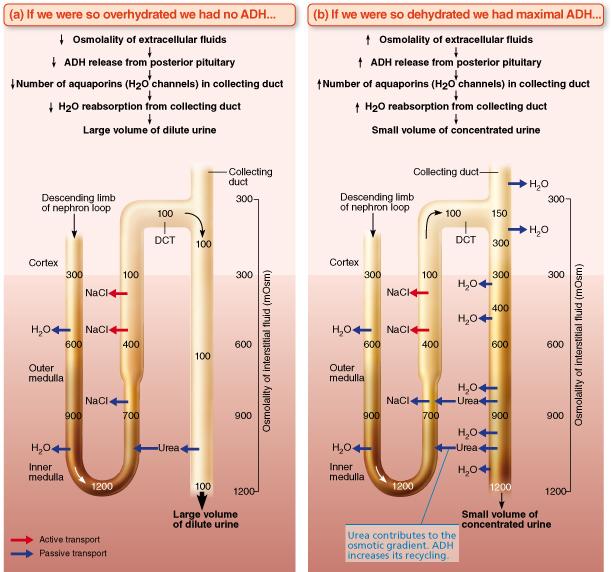
Where does antidiuretic hormone (ADH) exert its effects to promote water reabsorption?
descending limb of the nephron loop
collecting duct
ascending limb of the nephron loop
distal convoluted tubule (DCT)
Collecting duct
An increase in the permeability of the cells of the collecting tubule to water is due to a(n) ________.
increase in the production of aldosterone
decrease in the
concentration of the blood plasma
decrease in the production of
ADH
increase in the production of ADH
Increase in the production of ADH
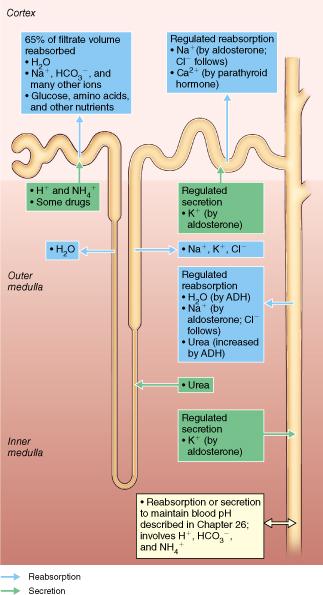
In what part of the renal tubule are aquaporins scarce or absent so that water CANNOT be reabsorbed?
descending limb of the nephron loop
proximal convoluted
tubule (PCT)
collecting duct
ascending limb of the
nephron loop
Ascending limb of the nephron loop
What is the largest component of urine by weight, other than water?
creatine
salt
phosphates
urea
Urea
True or False:
The proximal convoluted tubule is the portion of the nephron that attaches to the collecting duct.
False
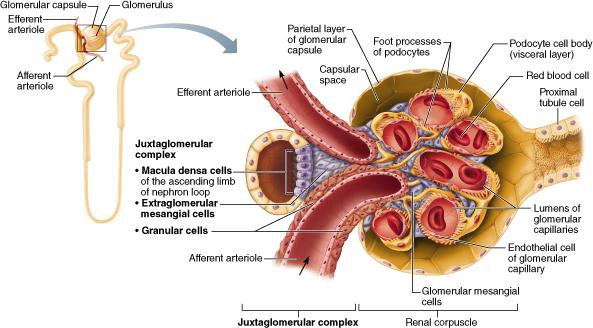
Where is filtrate produced in the nephron?
vasa recta
peritubular capillaries
glomerulus
juxtaglomerular complex
Glomerulus
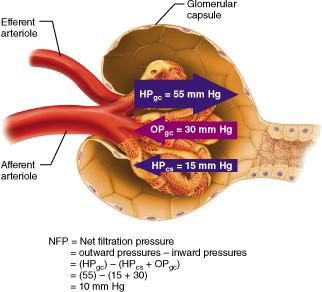
Which pressure is the chief force pushing water and solutes out of the blood and across the filtration membrane of the glomerulus?
colloid osmotic pressure in the capsular space
colloid osmotic pressure in glomerular capillaries (OPgc)
hydrostatic pressure in the capsular space (HPcs)
hydrostatic pressure in glomerular capillaries (HPgc)
hydrostatic pressure in glomerular capillaries (HPgc)
Where in the nephron does most solute reabsorption occur?
proximal convoluted tubule
distal convoluted tubule
glomerulus
collecting duct
Proximal convoluted tubule
The macula densa cells respond to ________.
changes in pressure in the tubule
aldosterone
antidiuretic hormone
changes in solute content of the filtrate
changes in solute content of the filtrate
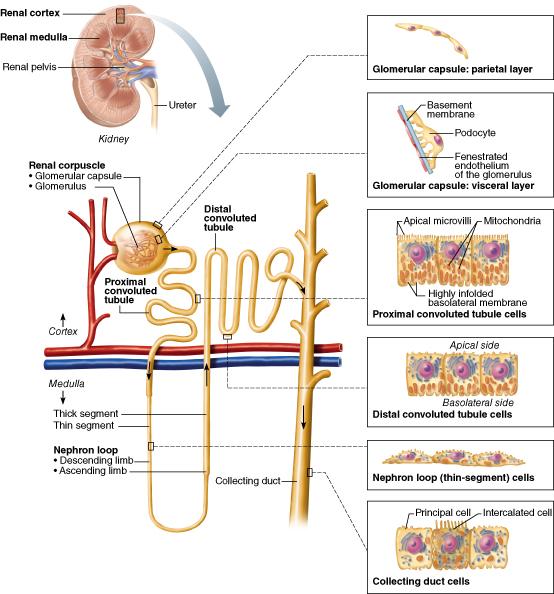
What two structures constitute the renal corpuscle?
glomerulus and renal tubule
renal tubule and collecting duct
proximal convoluted tubule and nephron loop
glomerulus and glomerular (Bowman's) capsule
glomerulus and glomerular (Bowman's) capsule
True or False:
Aldosterone is a hormone that causes the renal tubules to reclaim sodium ions from the filtrate.
True
True or False:
Under normal conditions, the proximal convoluted tubule reabsorbs all of the glucose, lactate, and amino acids in the filtrate and 65% of the Na+ and water.
True
Which of the following is not a part of the juxtaglomerular apparatus?
podocyte cells
granular cells
mesangial cells
macula densa
Podocyte cells
Which of the choices below are the most important hormone regulators of electrolyte reabsorption and secretion?
angiotensin I and epinephrine
angiotensin II and ADH
angiotensin II and aldosterone
angiotensin I and atrial
natriuretic peptide
angiotensin II and aldosterone
True or False :
In the kidneys, the countercurrent mechanism involves the interaction between the flow of filtrate through the loop of Henle of the juxtamedullary nephrons (the countercurrent multiplier) and the flow of blood through the limbs of adjacent blood vessels (the countercurrent exchanger). This relationship establishes and maintains an osmotic gradient extending from the cortex through the depths of the medulla that allows the kidneys to vary urine concentration dramatically. True False
TRUE
True or False :
Atrial naturetic peptide inhibits sodium reabsorption.
True
The glomerulus differs from other capillaries in the body in that it ________.
has a basement membrane
has a blood pressure much lower than otherorgan systems
is drained by an efferent arteriole
is impermeable to most substances
is drained by an efferent arteriole
The fluid in the glomerular (Bowman's) capsule is similar to plasma except that it does not contain a significant amount of ________.
glucose
electrolytes
hormones
plasma protein
Plasma protein
True or False:
The collecting duct is impermeable to water in the presence of ADH.
False
True or False:
Blood in the urine may be a symptom of bladder cancer.
True
True or False:
Despite the fact that the kidney's intrinsic controls work to maintain a constant GFR, in some situations the body's extrinsic controls will work to override these intrinsic controls in order to maintain systemic blood pressure.
True
Approximately 80% of the energy used for active transport is devoted to the reabsorption of __________.
glucose
potassium
sodium
water
Sodium
The kidneys are stimulated to produce renin ________.
when the specific gravity of urine rises above 1.10
when the peritubular capillaries are dilated
when the pH of the urine decreases
by a decrease in the blood pressure
By a decrease in the blood pressure
What is the effect of hyperventilation on pH?
metabolic alkalosis
respiratory alkalosis
metabolic
acidosis
respiratory acidosis
Respiratory alkalosis
True or False:
The single most important blood buffer system is the bicarbonate buffer system.
True
True or False:
As ventilation increases and more carbon dioxide is removed from the blood, the hydrogen ion concentration of the blood decreases.
True
True or False:
The normal pH of blood is 7.35-7.45.
True
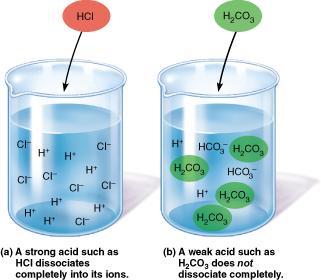
Which chemical buffer system is the only important system in the extracellular fluid (ECF) that resists short-term changes in pH?
physiological buffering systems
protein buffer system
bicarbonate buffer system
phosphate buffer system
Bicarbonate buffer system
Which age group most commonly has fluid, electrolyte, and acid-base balance issues?
the elderly
infants
growing children
young adults
Infants
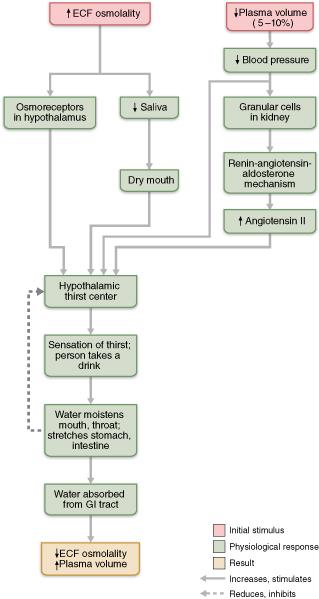
Which of the following is NOT involved in triggering the thirst mechanism?
increase in blood pressure
decrease in blood volume
osmoreceptors detect increased osmolality
dry mouth
Increase in blood pressure
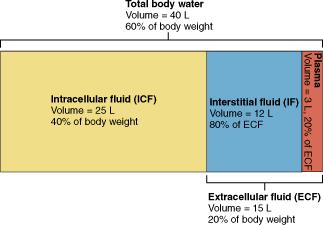
Select the person in the following list who would have the highest percentage of water in his or her body.
a 25-year-old overweight female
a 80-year-old man of average
weight
a 25-year-old male of average weight
a 6-month-old
baby boy
a 6 month old baby boy
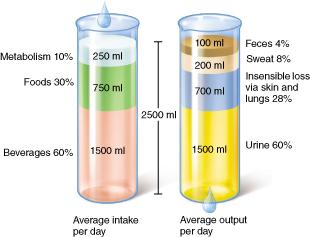
In a given day, what is the typical value for water intake?
1500 ml
750 ml
250 mL
2500 ml
2500 ml
What solute in body fluids determines most of their chemical and physical reactions?
glucose
electrolytes
nonelectrolytes
water
Electrolytes
A patient's anxiety caused her to develop respiratory alkalosis. What breathing technique did the nurse recommend, and why?
The nurse instructed the patient to breathe faster and deeper. This will decrease the patient's blood levels of carbon dioxide by eliminating more carbon dioxide from the lungs, resulting in a decrease in the blood pH.
The nurse instructed the patient to breathe more shallowly. This will decrease the patient's blood levels of carbon dioxide by eliminating more carbon dioxide from the lungs, resulting in a decrease in the blood pH.
The nurse instructed the patient to breathe slower and deeper, and to breathe into a paper bag. This will increase the patient's blood level of carbon dioxide by eliminating less carbon dioxide from the lungs, and by breathing in the expired air which has a higher concentration of carbon dioxide. As a result, the blood pH will decrease.
The nurse instructed the patient to breathe faster and deeper. This will increase the patient's blood levels of carbon dioxide by eliminating less carbon dioxide from the lungs, resulting in a decrease in the blood pH.
The nurse instructed the patient to breathe slower and deeper, and to breathe into a paper bag. This will increase the patient's blood level of carbon dioxide by eliminating less carbon dioxide from the lungs, and by breathing in the expired air which has a higher concentration of carbon dioxide. As a result, the blood pH will decrease.
Which of the following is not a method for regulating the hydrogen ion concentration in blood?
diet
chemical buffer systems
renal mechanism
respiratory changes
Diet
A falling blood pH and a rising partial pressure of carbon dioxide due to pneumonia or emphysema indicates ________.
respiratory alkalosis
respiratory acidosis
metabolic
alkalosis
metabolic acidosis
Respiratory acidosis
The fluid that bathes the cells found in tissues is called __________.
electrolytic fluid
interstitial fluid
intracellular
fluid
plasma
Interstitial fluid
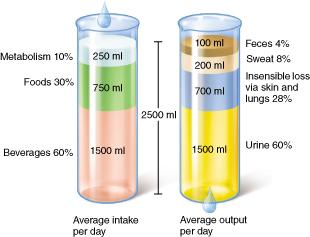
How much water is generated per day from cellular metabolism?
2500 ml
750 ml
1500 ml
250 ml
250 ml
The term alkaline reserve is used to describe the ________ buffer system.
hemoglobin
protein
phosphate
bicarbonate
Bicarbonate
Which of the following is not a chemical buffer system?
phosphate
nucleic acid
protein
bicarbonate
Nucleic acid
The most important renal mechanism for regulating acid-base balance of the blood involves __________.
maintaining water balance
maintaining phosphate balance
maintaining HCO3- balance.
maintaining CO2 balance
maintaining HCO3- balance.
The most common cause of acid-base imbalance is __________.
respiratory acidosis
respiratory alkalosis
metabolic
acidosis
metabolic alkalosis
Respiratory acidosis
A patient is breathing slowly and blood pH analysis indicates an abnormally high value. What is the likely diagnosis?
respiratory alkalosis
respiratory acidosis
metabolic
alkalosis
metabolic acidosis
Metabolic alkalosis
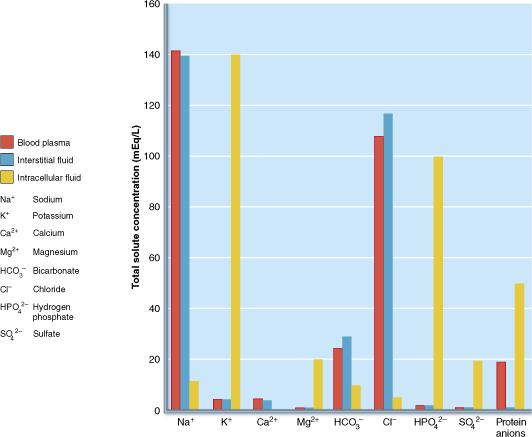
What is the most common cation found in the interstitial fluid?
HPO42-
Na+
Cl-
K+
Na+
Blood analysis indicates a low pH, and the patient is breathing rapidly. Given your knowledge of acid-base balance, which of the following is most likely?
respiratory alkalosis
metabolic alkalosis
metabolic
acidosis
respiratory acidosis
Metabolic acidosis
The term hypotonic hydration refers to ________.
a condition that may result from renal insufficiency or drinking extraordinary amounts of water
the unpleasant feeling people have after drinking too much liquor
the feeling one might have after profuse sweating with exertion
a condition that is caused by high levels of sodium in the extracellular fluid compartment
a condition that may result from renal insufficiency or drinking extraordinary amounts of water
True or False:
The most abundant cation in intracellular fluid is sodium.
False
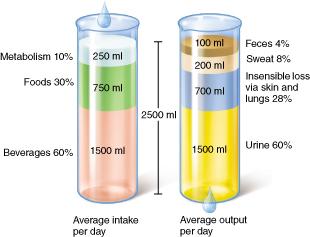
What accounts for the route through which most fluid is lost in a day?
sweat
insensible loss through skin and lungs
feces
urine
Urine
The factor favoring filtrate formation at the glomerulus is the ________.
myogenic mechanism
glomerular hydrostatic pressure
colloid osmotic pressure of the blood
capsular hydrostatic pressure
Glomerular hydrostatic pressure
True or False:
Glomerular hydrostatic pressure (HPg) is the chief force pushing water and solutes out of the blood and across the filtration membrane.
True
True or False:
In the absence of hormones, the distal tubule and collecting ducts are relatively impermeable to water.
True
Alcohol acts as a diuretic because it ________.
inhibits the release of ADH
is not reabsorbed by the tubule
cells
increases secretion of ADH
increases the rate of
glomerular filtration
Inhibits the release of ADH
What is the juxtaglomerular apparatus?
a system for concentrating urine
a system for diluting urine
a system that regulates the rate of filtrate formation and systemic blood pressure
a system that protects the nephron from some chemicals found in blood
a system that regulates the rate of filtrate formation and systemic blood pressure
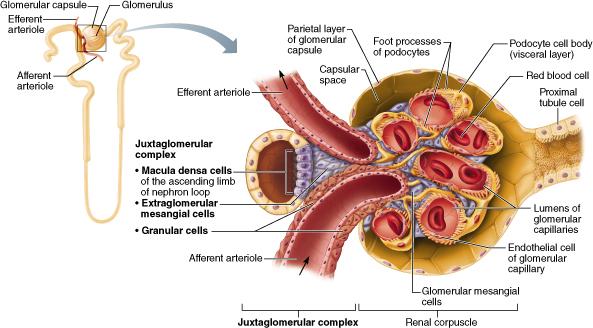
What is the function of the macula densa cells of the juxtaglomerular complex (JGC)?
The macula densa cells pass regulatory signals between the extraglomerular mesangial cells.
The macula densa cells produce filtrate.
The macula densa cells monitor the NaCl content of the filtrate entering the distal convoluted tubule.
The macula densa cells sense blood pressure in the afferent arteriole.
The macula densa cells monitor the NaCl content of the filtrate entering the distal convoluted tubule.
Which of the following is the functional unit of the kidney?
renal pyramid
renal corpuscle
renal pelvis
nephron
Nephron
True or False:
The entire responsibility for urine formation lies with the nephron.
True
Which of the following is NOT a major urine formation process?
glomerular filtration
micturition
tubular
secretion
tubular reabsorption
Micturition
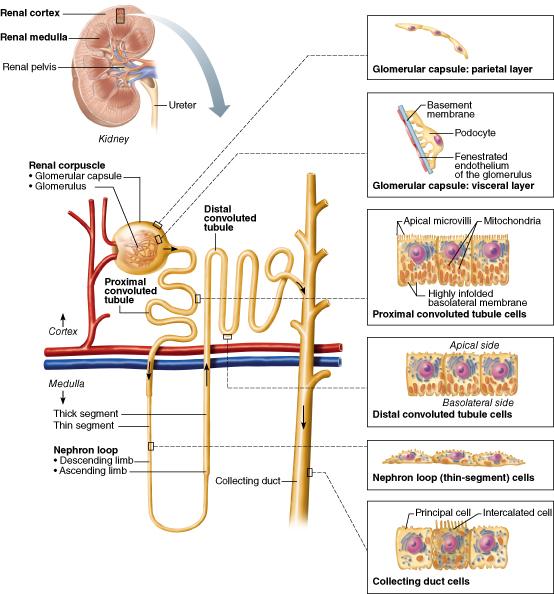
In which kidney region are all renal corpuscles located?
renal medulla
renal pelvis
renal columns
renal cortex
Renal cortex
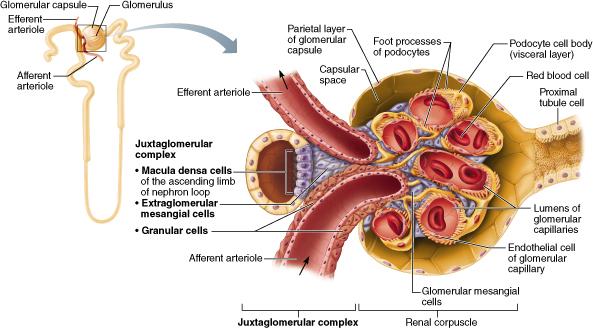
What vessel directly feeds into the glomerulus?
efferent arteriole
vasa recta
afferent arteriole
cortical radiate artery
Afferent arteriole
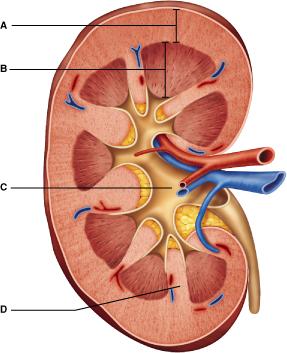
What region subdivides to form two or three major calyces and several minor calyces? Select from letters A-D.
A
B
C
D
C
True or False:
Prolonged hyperventilation can cause alkalosis.
True
Whereas sodium is found mainly in the extracellular fluid, most ________ is found in the intracellular fluid.
potassium
bicarbonate
iron
chloride
Potassium
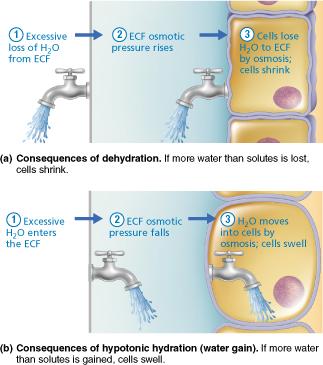
What type of water imbalance increases the amount of fluid in all compartments?
dehydration
hypotonic hydration
edema
inflammation
hypotonic hydration
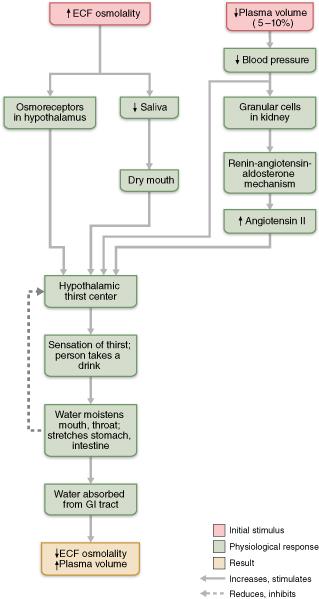
What receptors does the brain use to detect changes in osmolality?
baroreceptors
chemoreceptors
thermoreceptors
osmoreceptors
Osmoreceptors
True or False:
Respiratory acidosis results when lungs are obstructed and gas exchange is inefficient.
True
The body's water volume is closely tied to a powerful water "magnet." What magnet is referred to here?
water level in the intracellular compartment
ionic
potassium
ionic sodium
water level in the extracellular compartment
Ionic sodium
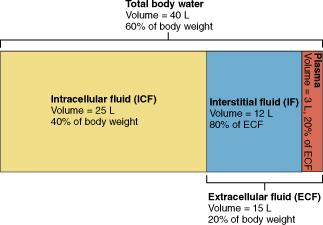
Where is the majority of water stored in the human body?
interstitial fluid (IF)
extracellular fluid (ECF)
compartment
plasma
intracellular fluid (ICF) compartment
intracellular fluid (ICF) compartment
Respiratory acidosis can occur when ________.
a person's breathing is shallow due to obstruction
the kidneys secrete hydrogen ions
a runner has completed a very long marathon
a person consumes excessive amounts of antacids
a person's breathing is shallow due to obstruction
The role of ADH is to __________.
decrease water reabsorption
lower blood pressure
produce
dilute urine
increase water reabsorption
Increase water reabsorption
True and False:
Potassium balance is controlled mainly by renal mechanisms.
True